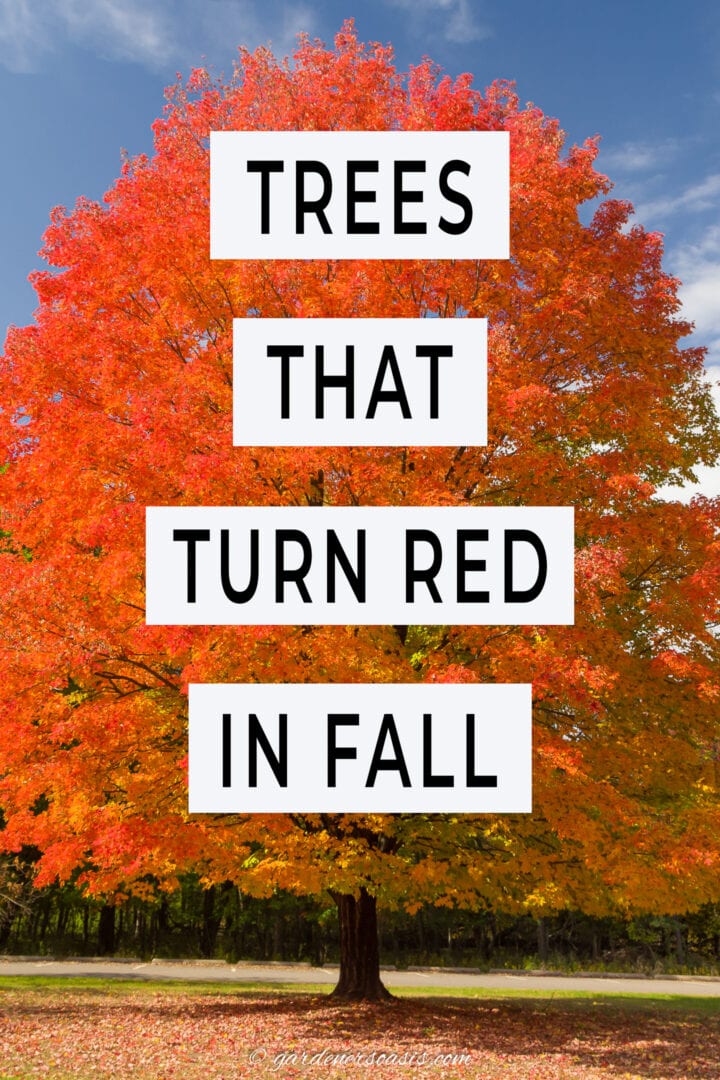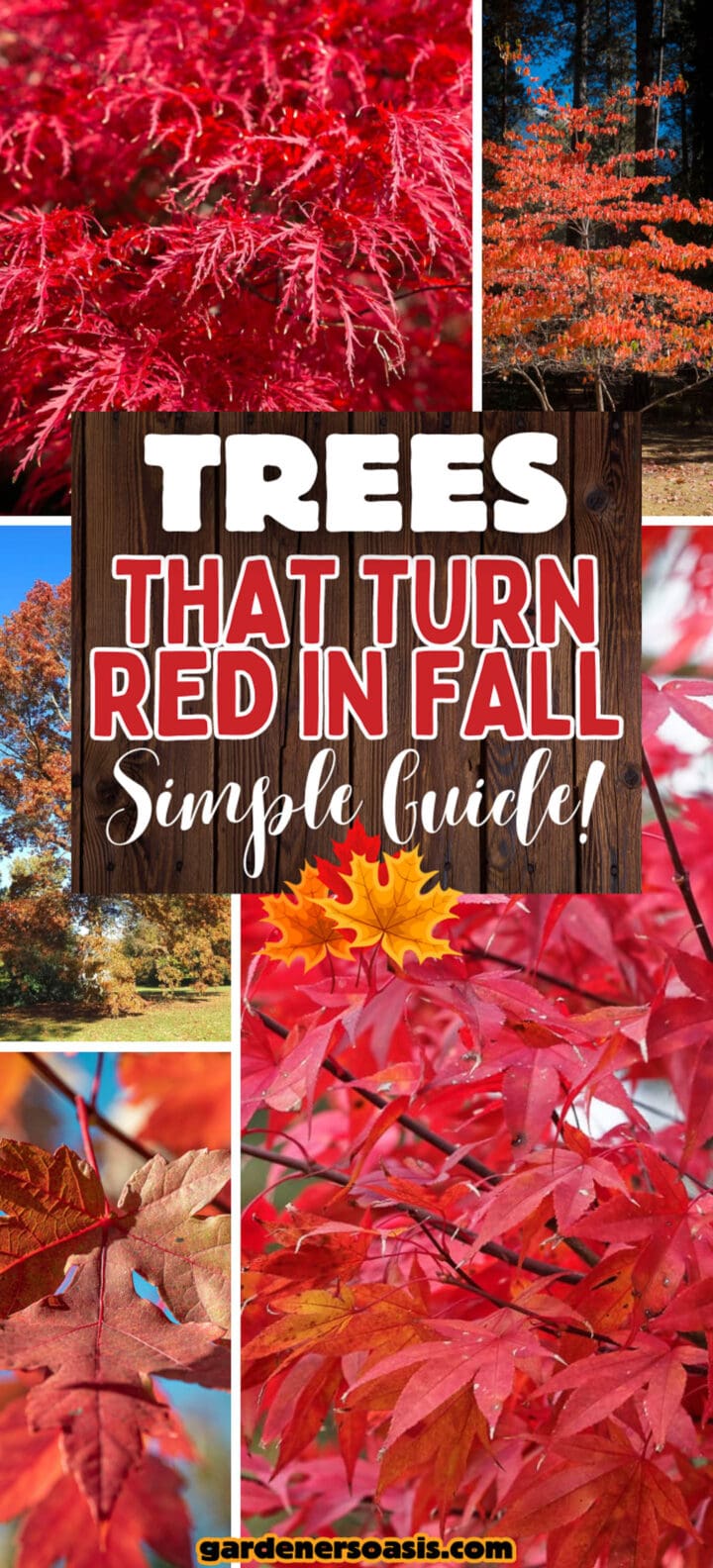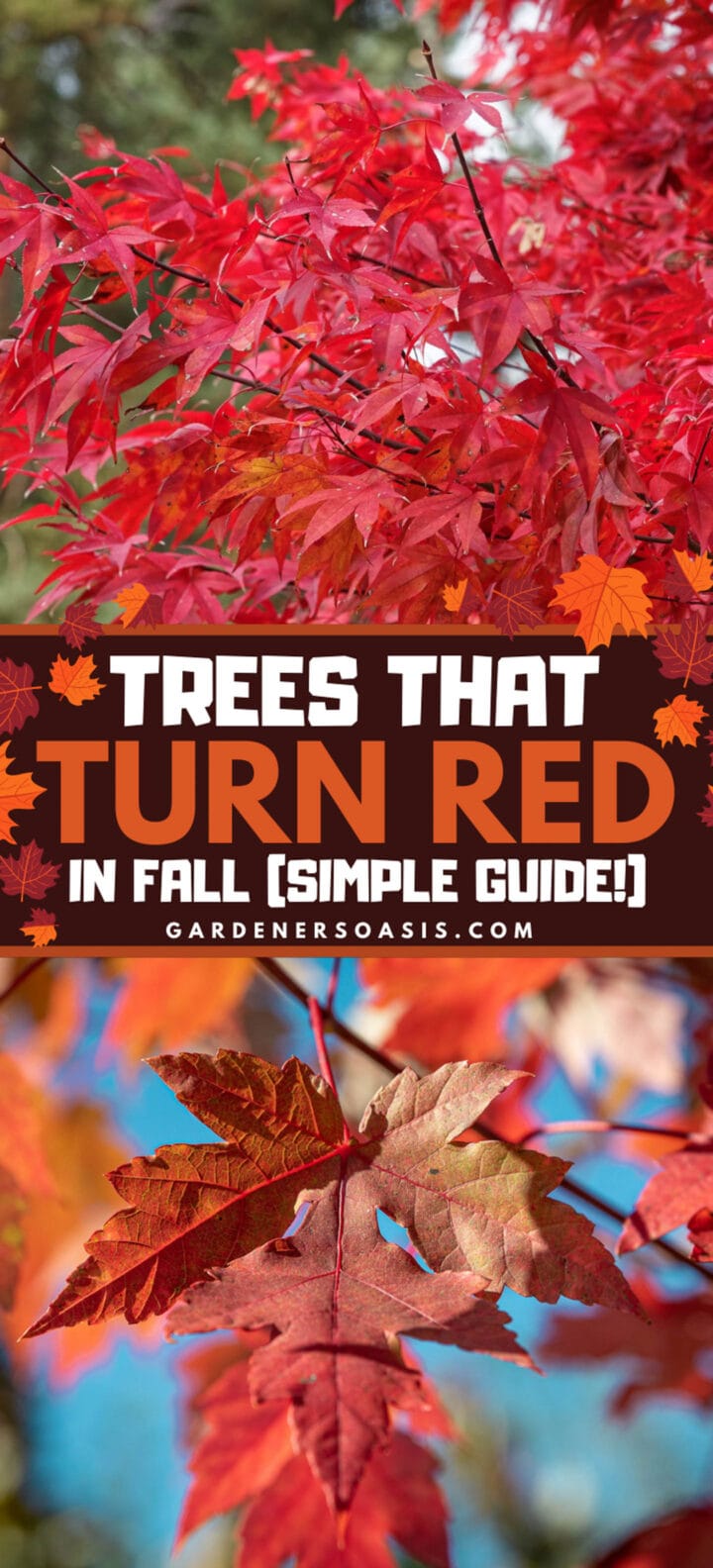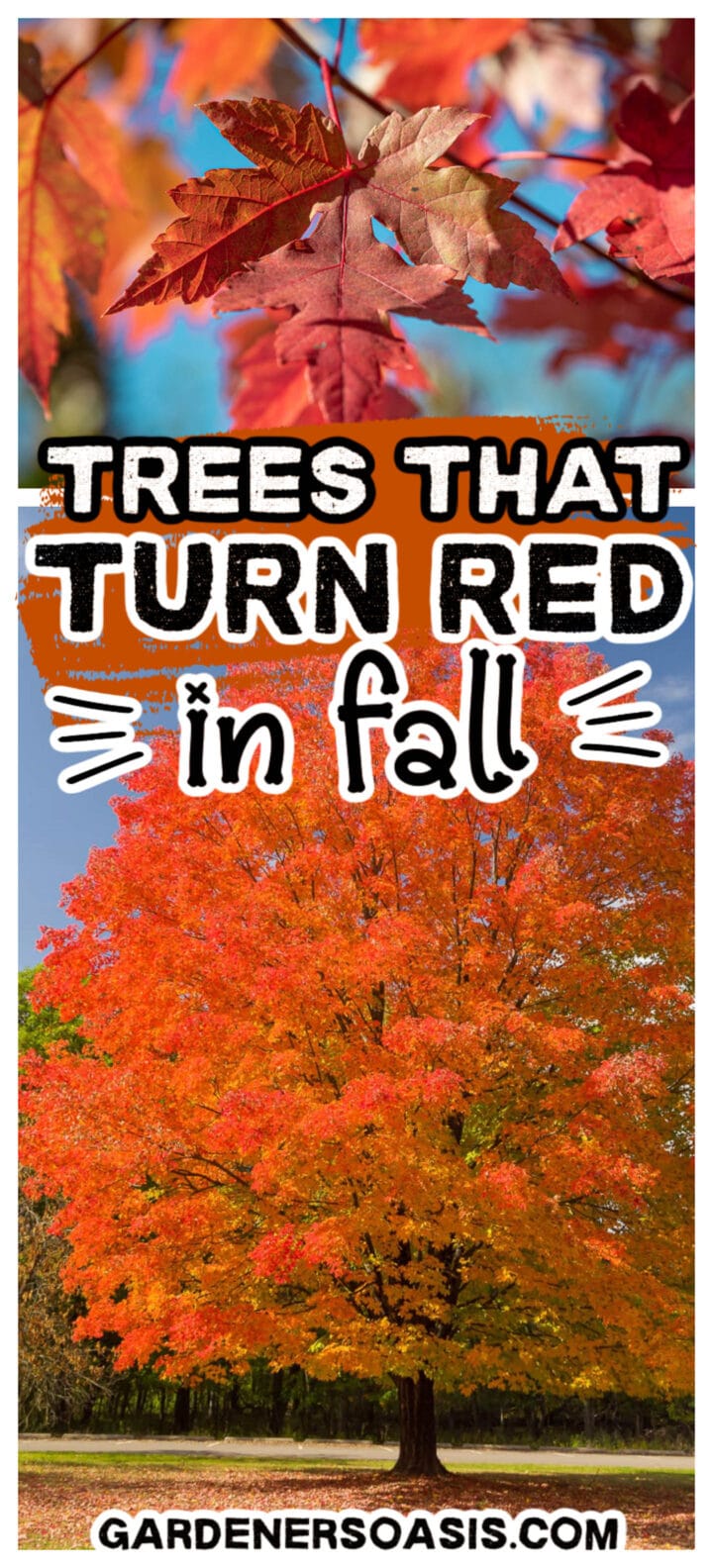Trees That Turn Red In Fall
Whether you’re planning a garden makeover or just want to add a splash of color to your fall garden, this guide will introduce you to a variety of trees that turn red in fall. From dogwoods to crape myrtles to the best maples, you’re sure to find the perfect tree to bring that fiery charm to your personal outdoor sanctuary..
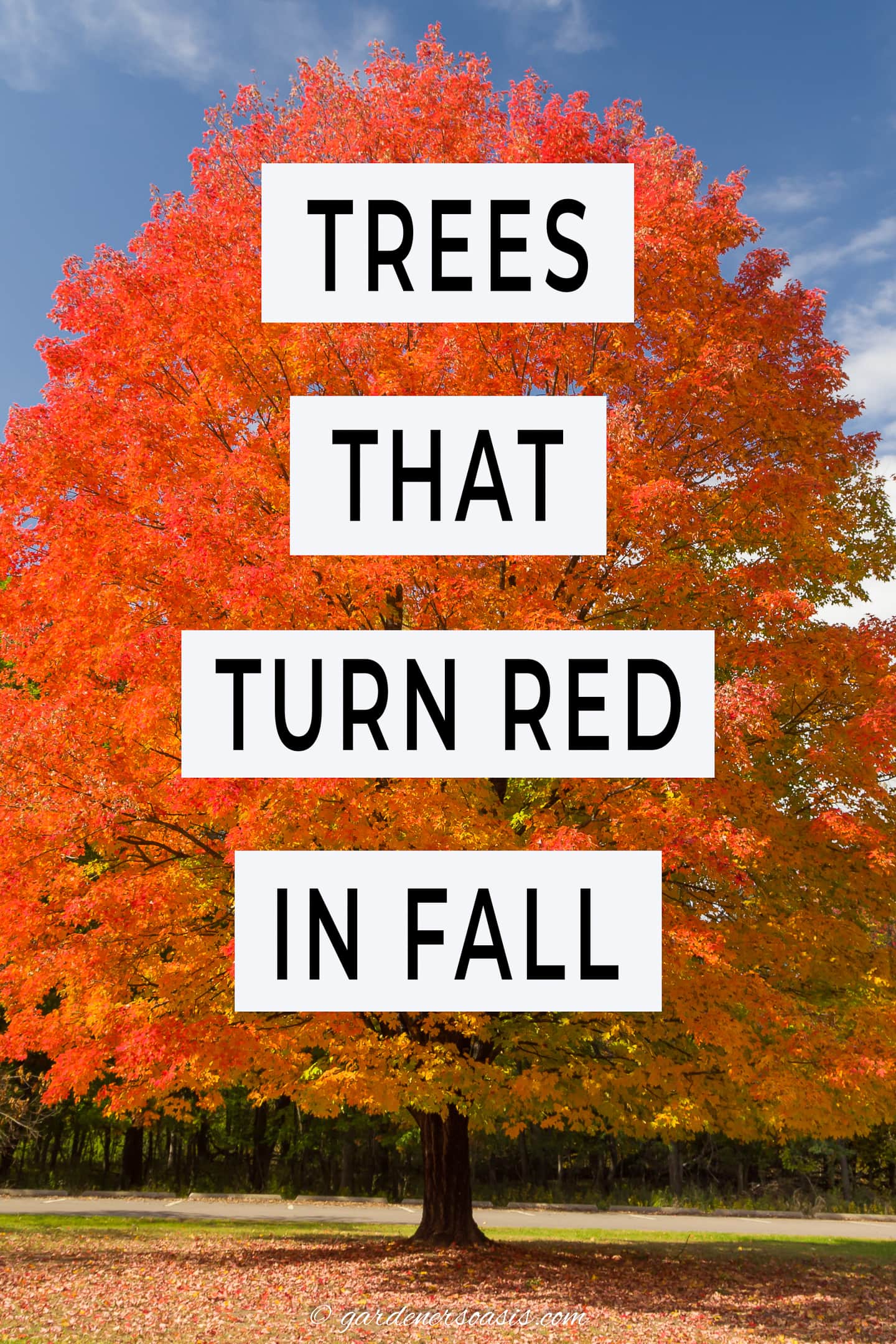
As the seasons shift and the air becomes crisp, I always look forward to the vibrant display of red fall leaves.
While several trees boast beautiful fall color, there are specific ones that stand out with their fiery red fall color.
So whether you’re looking for majestic, towering specimens or small trees that turn red in fall, this guide will provide a comprehensive list of trees known for their stunning red leaves in autumn.
1 | Maple trees
Maples are probably the most iconic of all the fall color trees.
They are fairly easy to grow and are celebrated for their majestic stature and distinctive, often lobed leaves.
Native to various regions across the Northern Hemisphere, these deciduous trees are especially revered for their brilliant autumnal displays, where their foliage transforms into vibrant hues of red, orange, and gold.
Here are a few of the most popular red-leaved varieties.
Sugar Maple
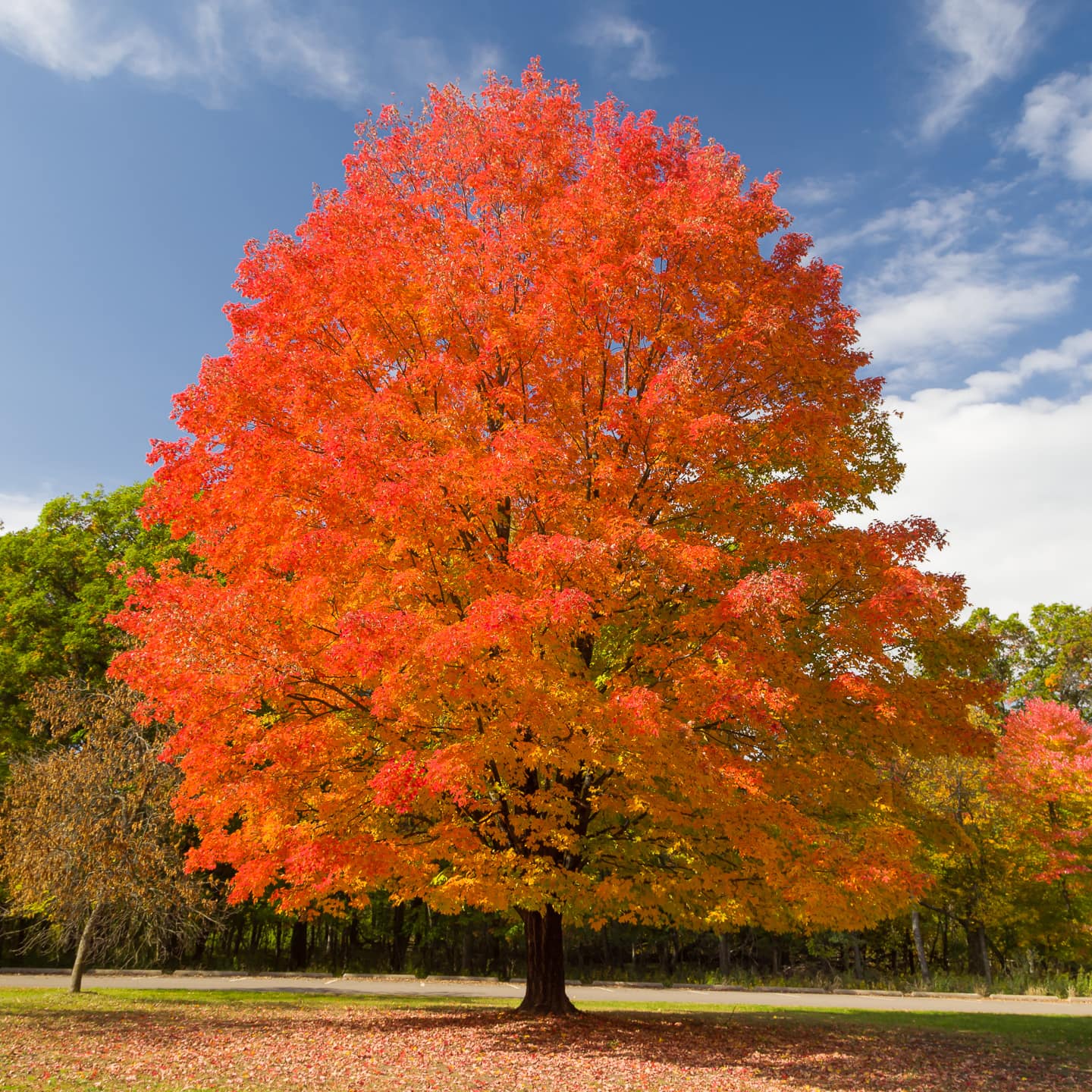
Scientific name: Acer saccharum
Zone: 3 to 8
Exposure: Full sun to partial shade
Height: 60′ to 75′
Width: 40′ to 50′
Bloom time: foliage only
Flower color: N/A
- Recognized for its vibrant red-orange fall colors and the sap that’s the primary source for maple syrup.
- Prefers well-drained soil.
Silver maple
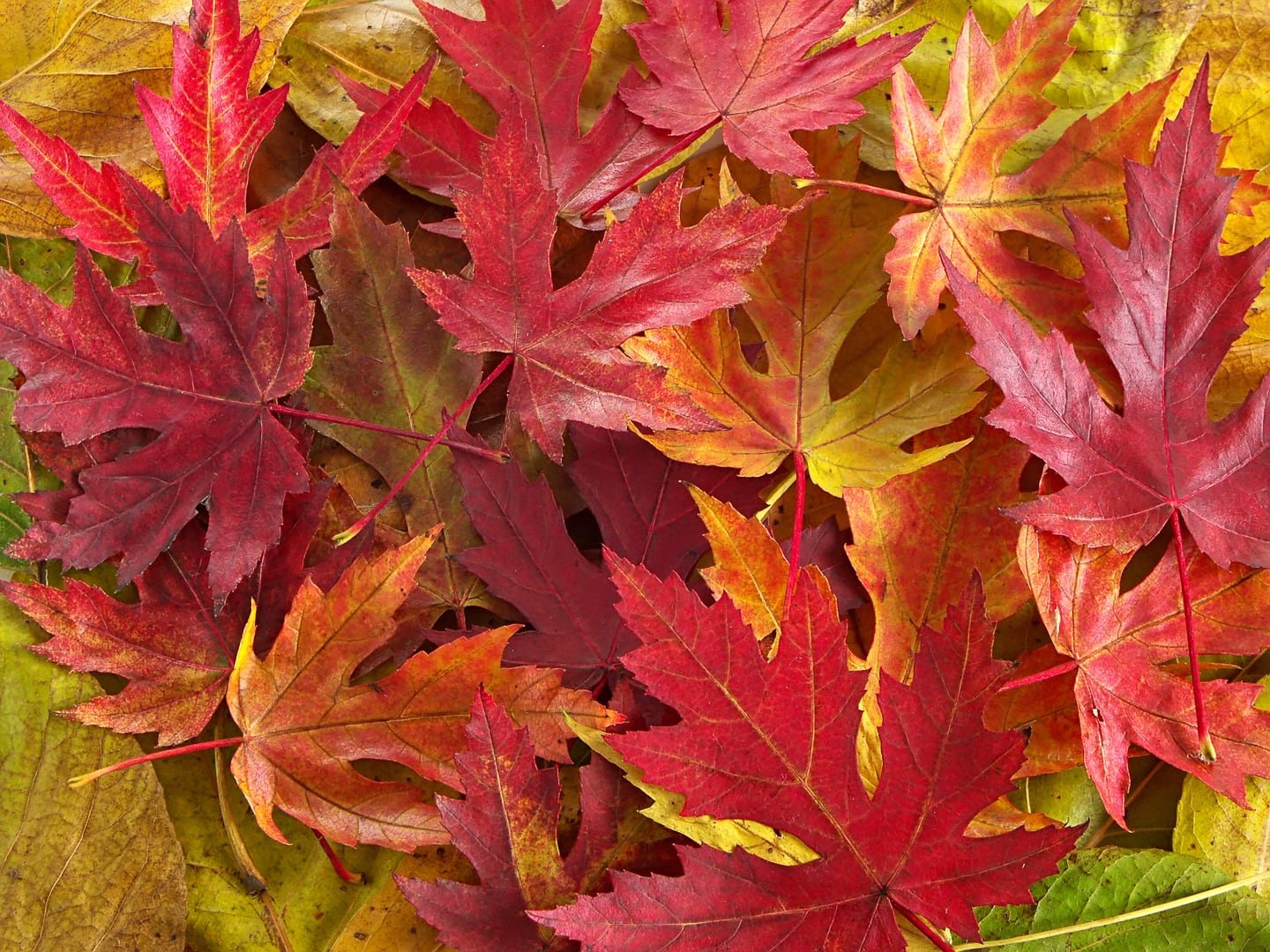
Scientific name: Acer saccharinum
Zone: 3 to 9
Exposure: Full sun
Height: 50′ to 80′
Width: 35′ to 50′
Bloom time: foliage only
Flower color: N/A
- Adaptable to various soil types
- A fast-growing tree with leaves that turn a reddish-yellow in the fall.
Autumn blaze maple
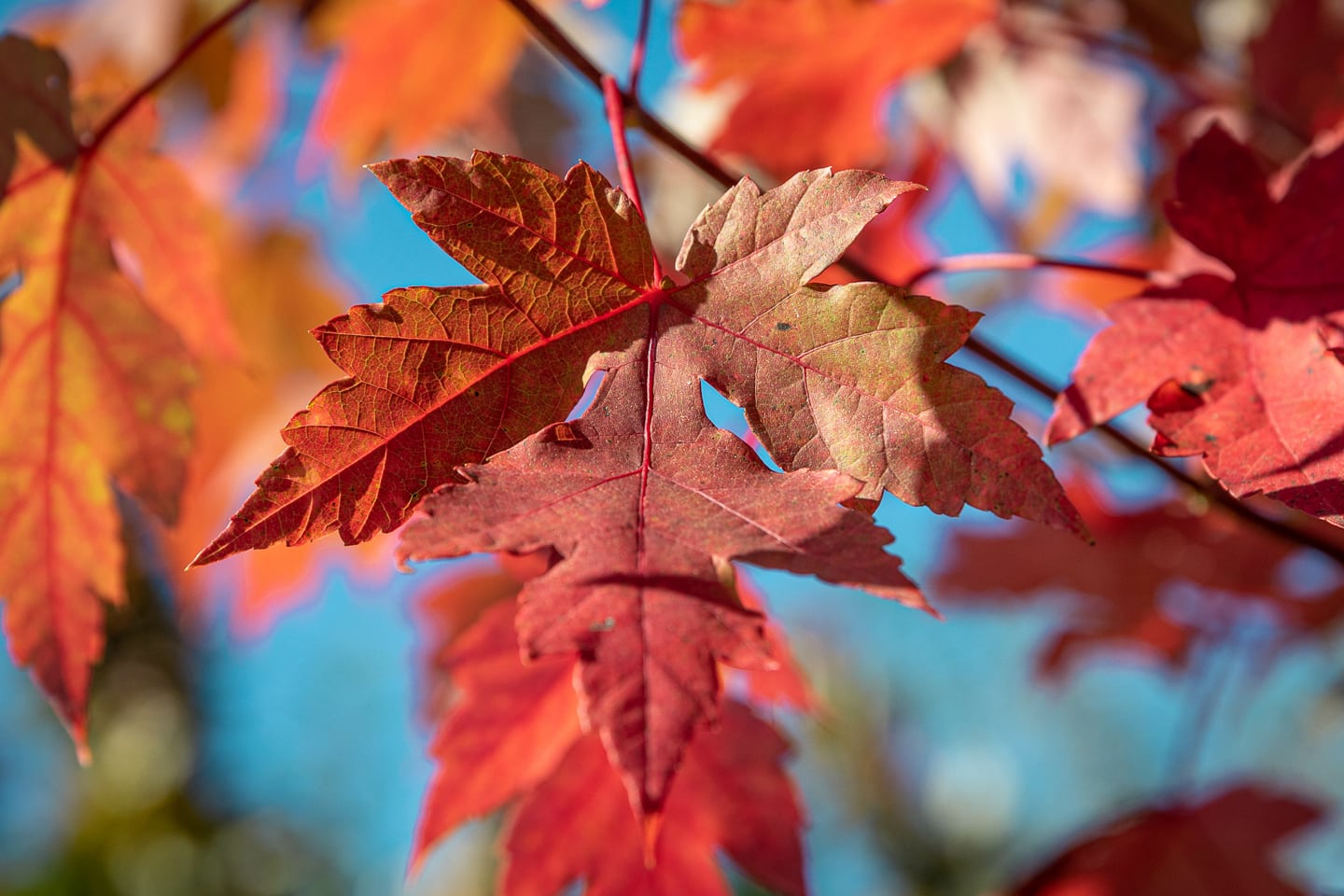
Scientific name: Acer x freemanii
Zone: 3 to 8
Exposure: Full sun to partial shade
Height: 40′ to 55′ tall
Width: 30′ to 40′ wide
Bloom time: foliage only
Flower color: N/A
- Thrives in a range of soil types.
- A hybrid of the Silver and Red Maples, it’s a fast grower that boasts vibrant red leaves in autumn.
- Has won numerous “best tree” awards.
Red maple ‘Brandywine’
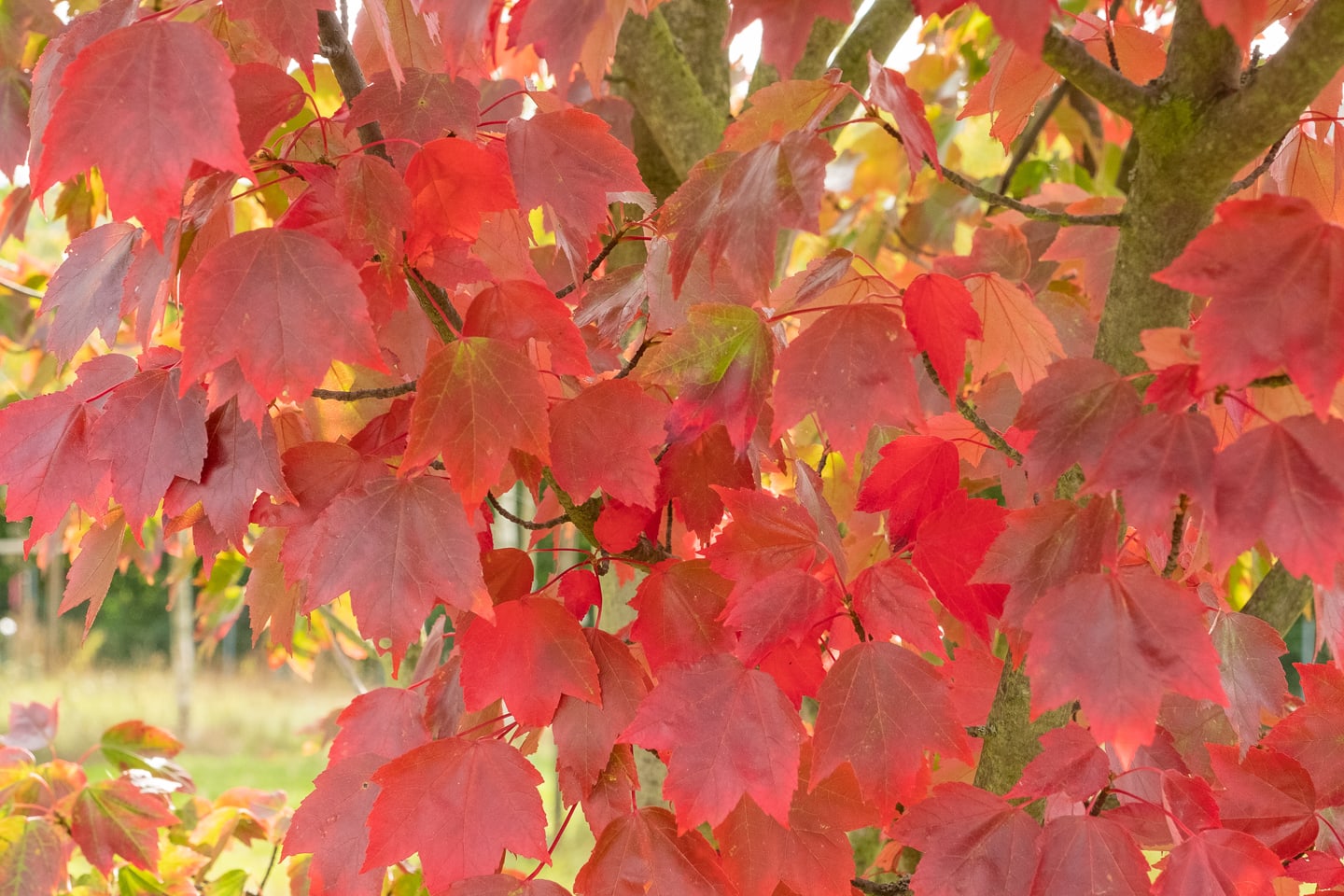
Scientific name: Acer rubrum ‘Brandywine’
Zone: 4 to 9
Exposure: Full sun
Height: 25′ to 30′
Width: 15′ to 25′
Bloom time: foliage only
Flower color: N/A
- A compact variety, it offers a spectacular display of deep red leaves in the fall.
- Prefers moist, well-drained soils.
2 | Japanese maples
Japanese maples are a captivating species within the Acer genus, renowned for their delicate, often lace-like foliage and compact stature.
Native to Japan, Korea, and China, these deciduous trees are celebrated for their wide array of leaf colors and shapes, ranging from deep purples to vibrant reds and even soft greens.
Their graceful, often multi-branched form combined with stunning autumnal color transformations makes them a favorite in gardens, especially as ornamental focal points.
Fireglow Japanese maple
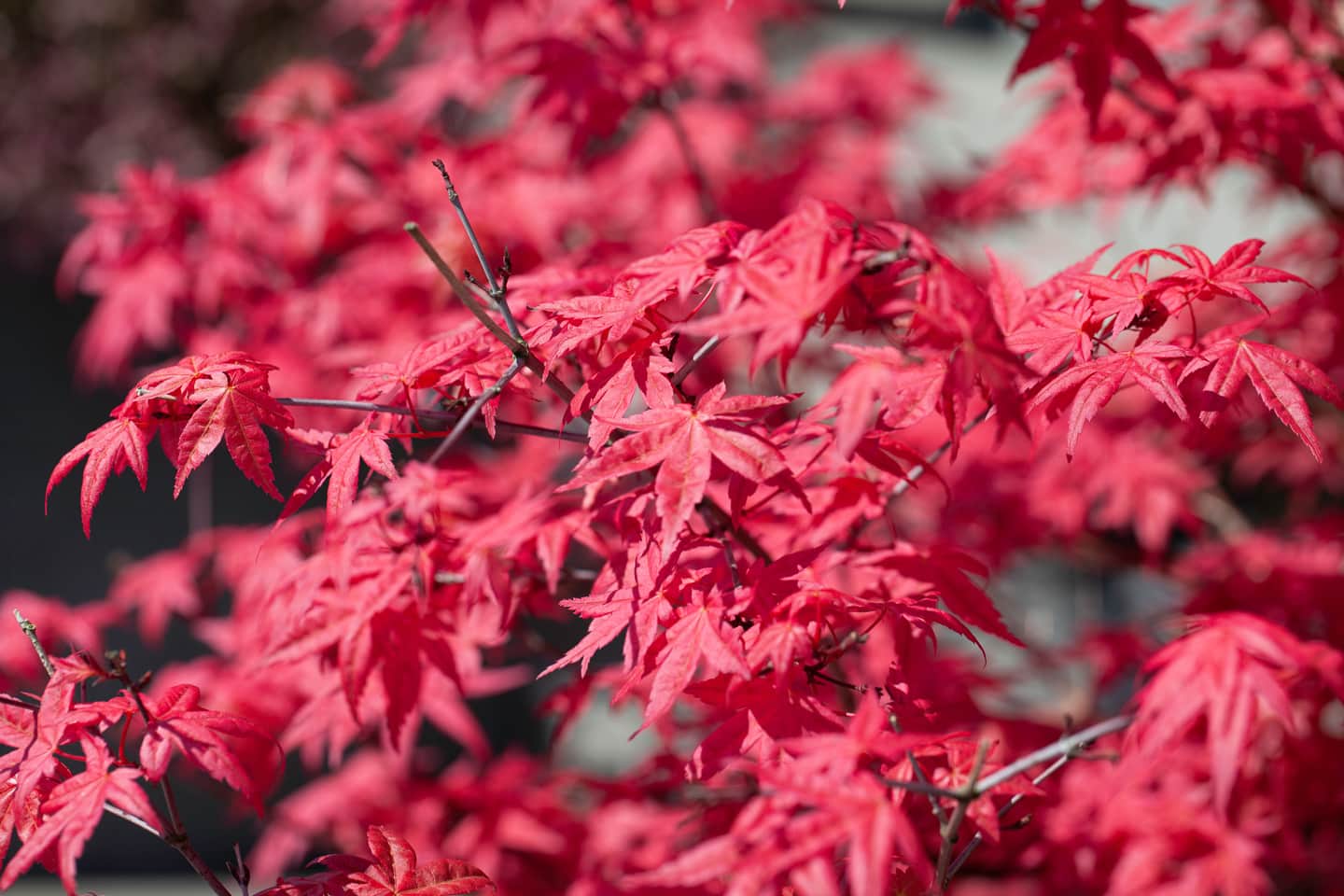
Scientific name: Acer palmatum ‘Fireglow’
Zone: 5 to 8
Exposure: Partial shade
Height: 15′ to 20′ tall
Width: 15′ to 20′ wide
Bloom time: foliage only
Flower color: N/A
- Prefers well-drained soil
- As the name suggests, its leaves turn a fiery red in autumn.
Bloodgood Japanese maple
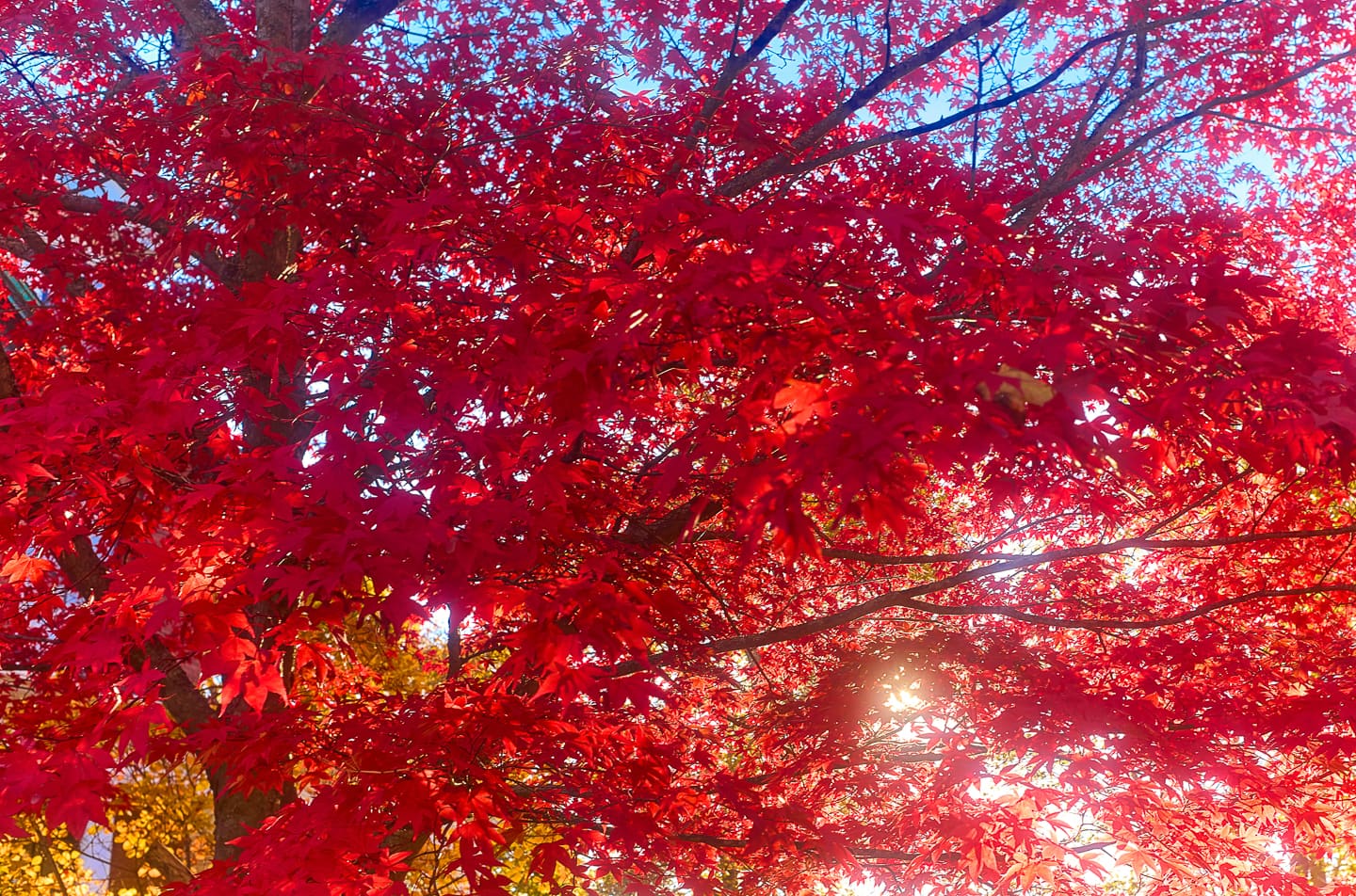
Scientific name: Acer palmatum ‘Bloodgood’
Zone: 5 to 8
Exposure: Partial shade
Height: 15′ to 20′ tall
Width: 15′ to 20′ wide
Bloom time: foliage only
Flower color: N/A
- A popular variety, it boasts deep red-purple leaves throughout the year, intensifying in the fall.
- Likes well-drained soil
Emperor One Japanese maple
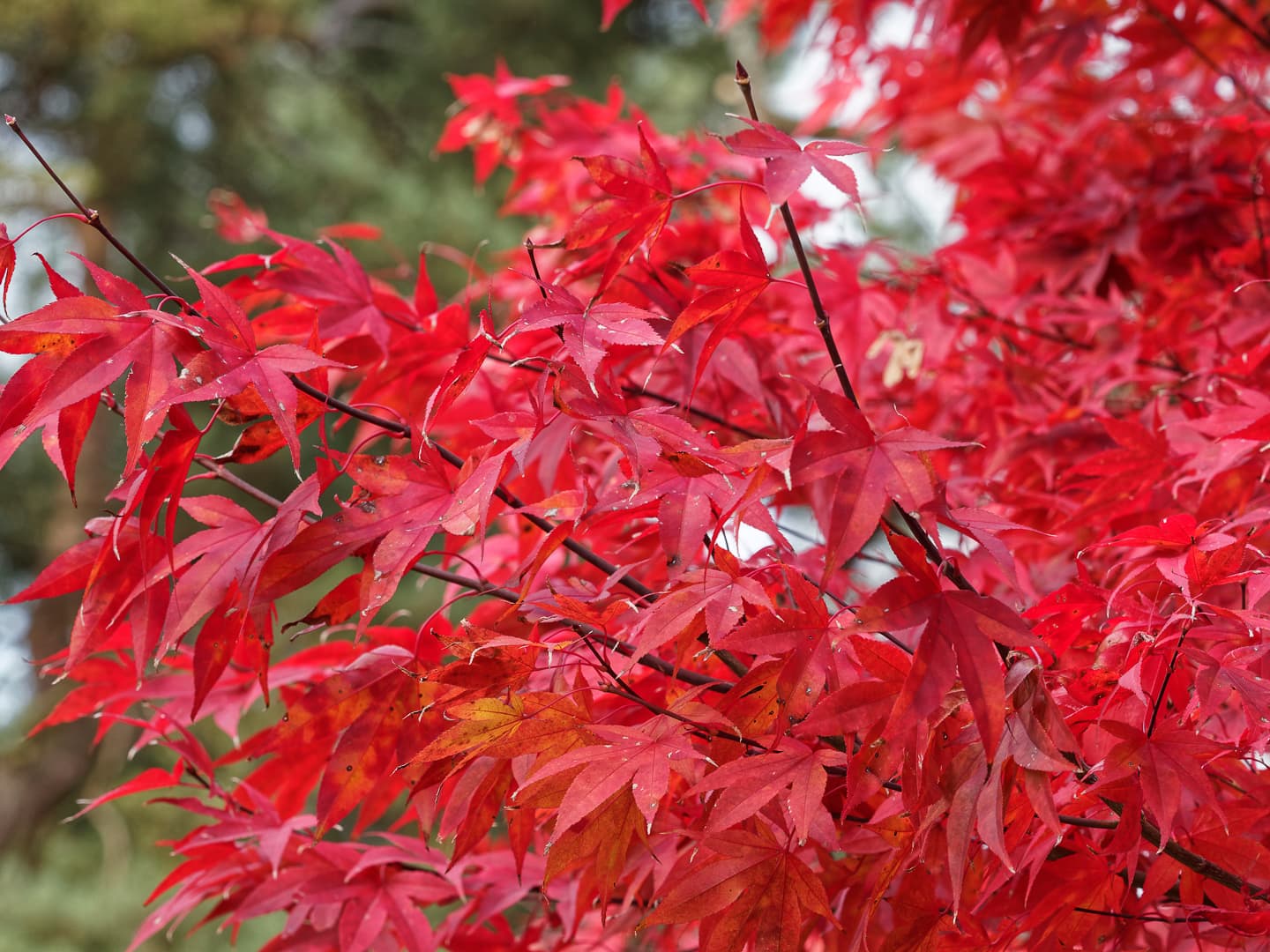
Scientific name: Acer palmatum ‘Emperor One’ or ‘Atropurpureum’
Zone: 5 to 8
Exposure: Partial shade but can tolerate full sun in cooler climates
Height: 15′ to 20′ tall
Width: 15′ to 20′ tall
Bloom time: foliage only
Flower color: N/A
- It boasts deep purple-red leaves in spring and summer, which turn a vibrant crimson-red in the fall.
- Its color can be more intense when planted in a sunnier location.
- The beautiful contrast of its delicate leaves against the vibrant color makes it a favorite among garden enthusiasts.
Tamukeyama Japanese maple
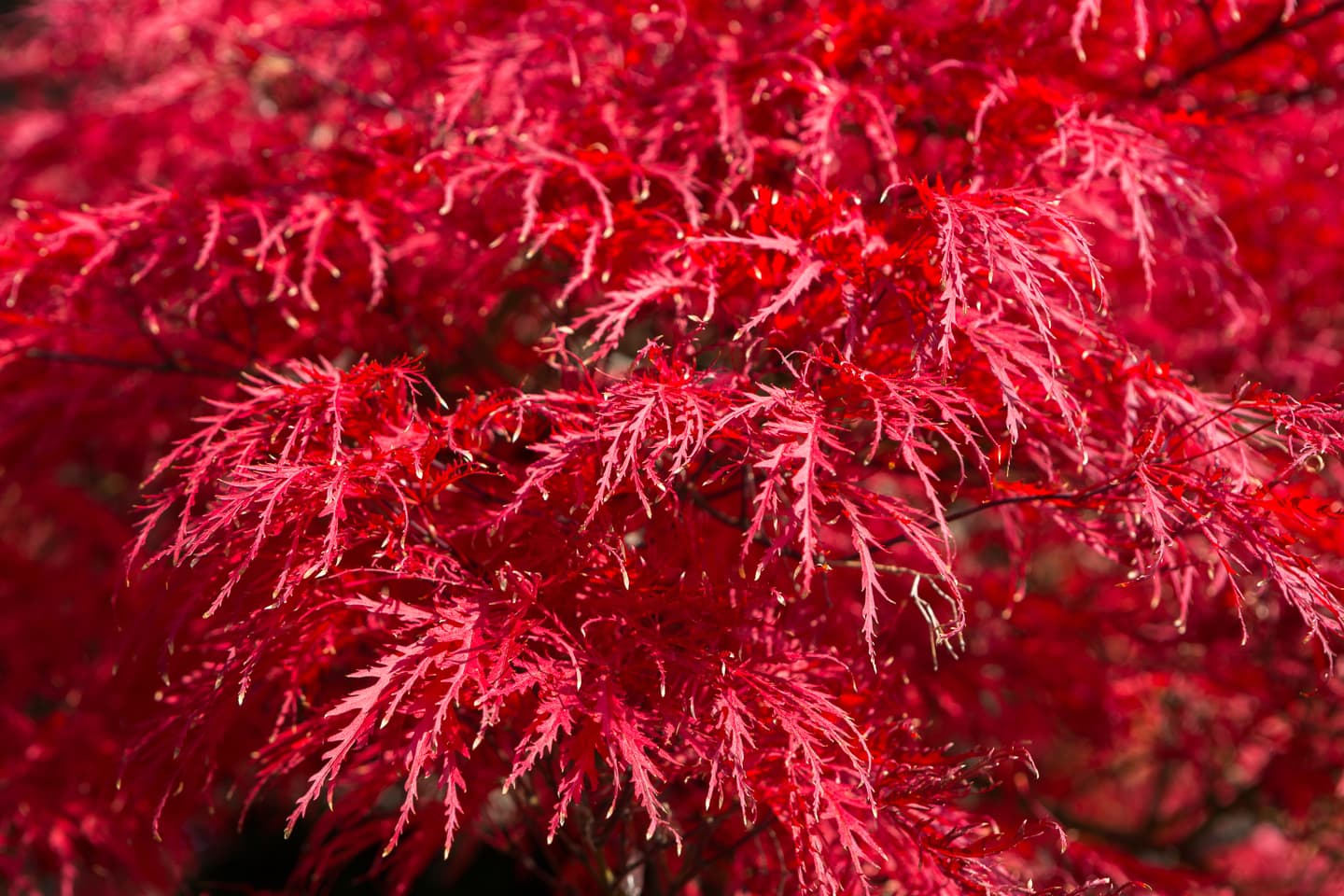
Scientific name: Acer palmatum ‘Tamukeyama’
Zone: 5 to 8
Exposure: Partial shade, but can tolerate more sun in cooler climates
Height: 6 to 8 feet tall
Width: 8 to 12 feet wide
Bloom time: foliage only
Flower color: N/A
- Prefers well-drained soil
- This is a laceleaf variety known for its deep crimson-red leaves that turn even brighter in the fall.
- Its cascading form makes it a favorite for landscapes.
3 | Oak trees
Oak trees, belonging to the genus Quercus, are strong and long-lived trees that have been growing in forests and landscapes worldwide for centuries.
Recognized for their robust, often lobed leaves and distinctive acorns, oaks are emblematic of endurance and resilience.
To get the best red fall leaves, look for the following varieties.
Scarlet oak
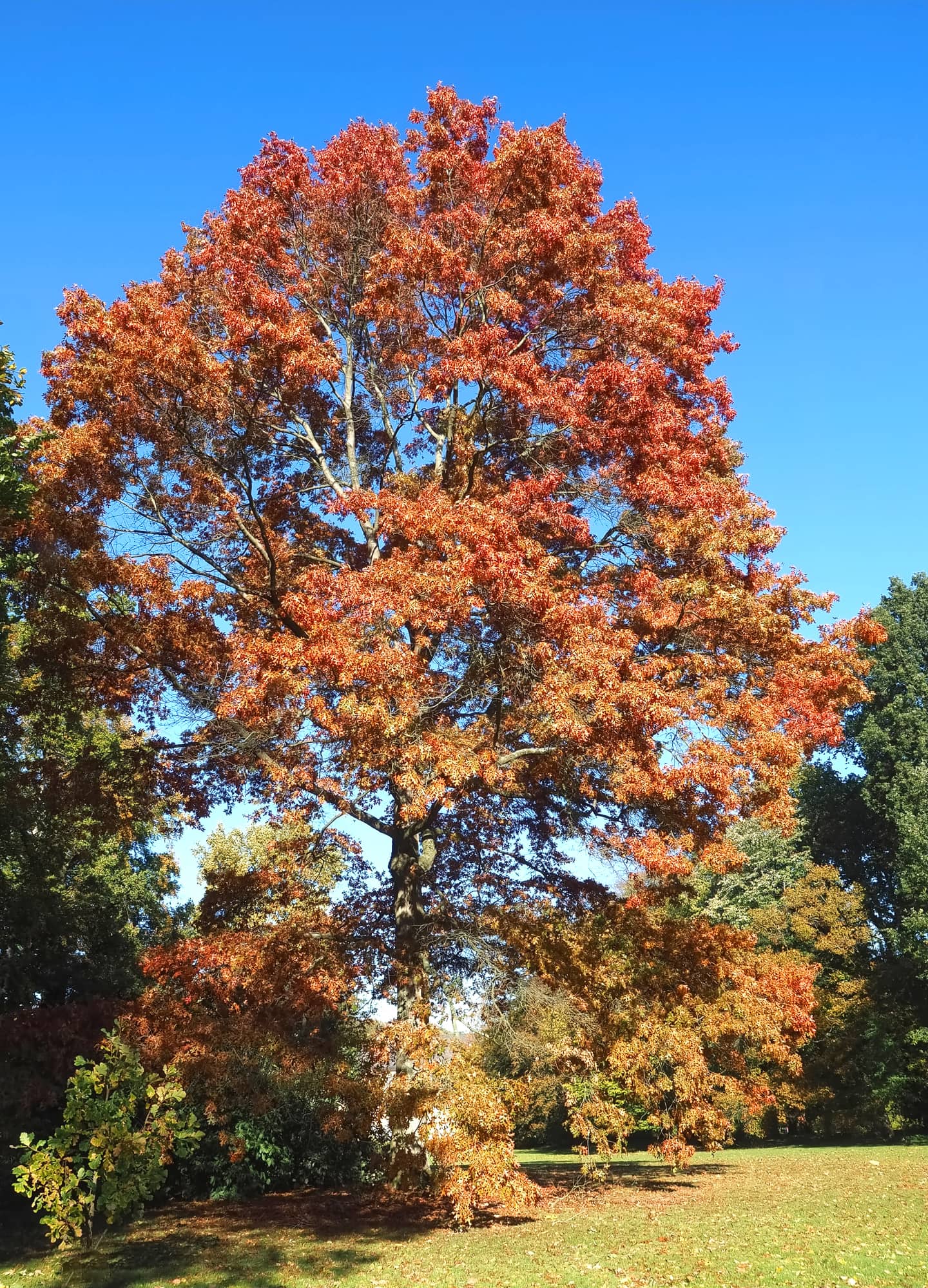
Scientific name: Quercus coccinea
Zone: 4 to 9
Exposure: Full sun
Height: 50′ to 70′ tall
Width: 40′ to 50′ wide
Bloom time: foliage only
Flower color: N/A
- Adaptable to various soil types
- Distinguished by its deeply lobed leaves and brilliant scarlet fall color.
Northern red oak
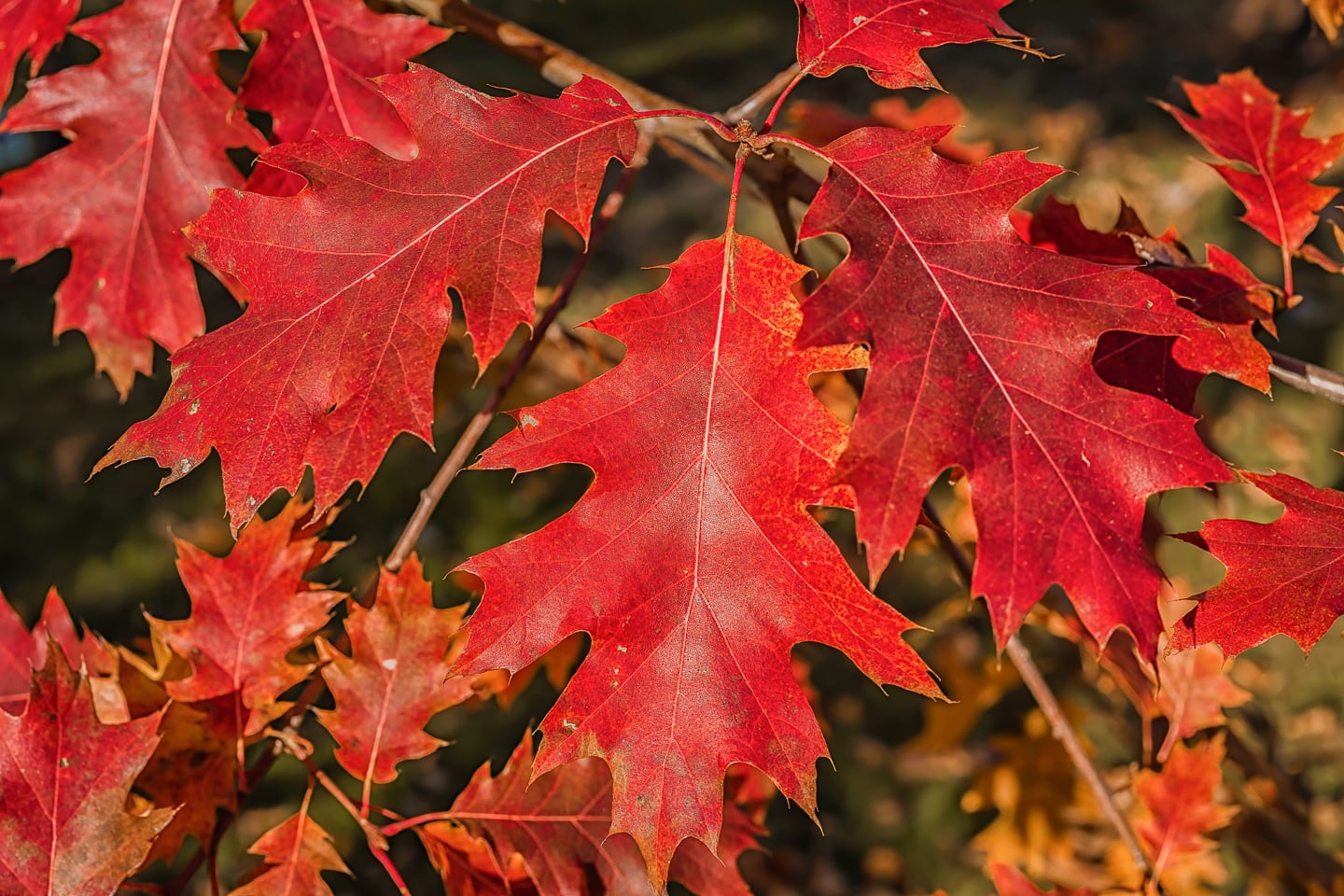
Scientific name: Quercus rubra
Zone: 3 to 8
Exposure: Full sun
Height: 60′ to 75′ tall
Width: 45′ to 50′ wide
Bloom time: foliage only
Flower color: N/A
- A majestic tree with a broad crown, producing acorns favored by wildlife.
- Prefers slightly acidic, well-drained soils
- A fast-growing oak, its leaves turn a brilliant red in the fall.
Shumard oak
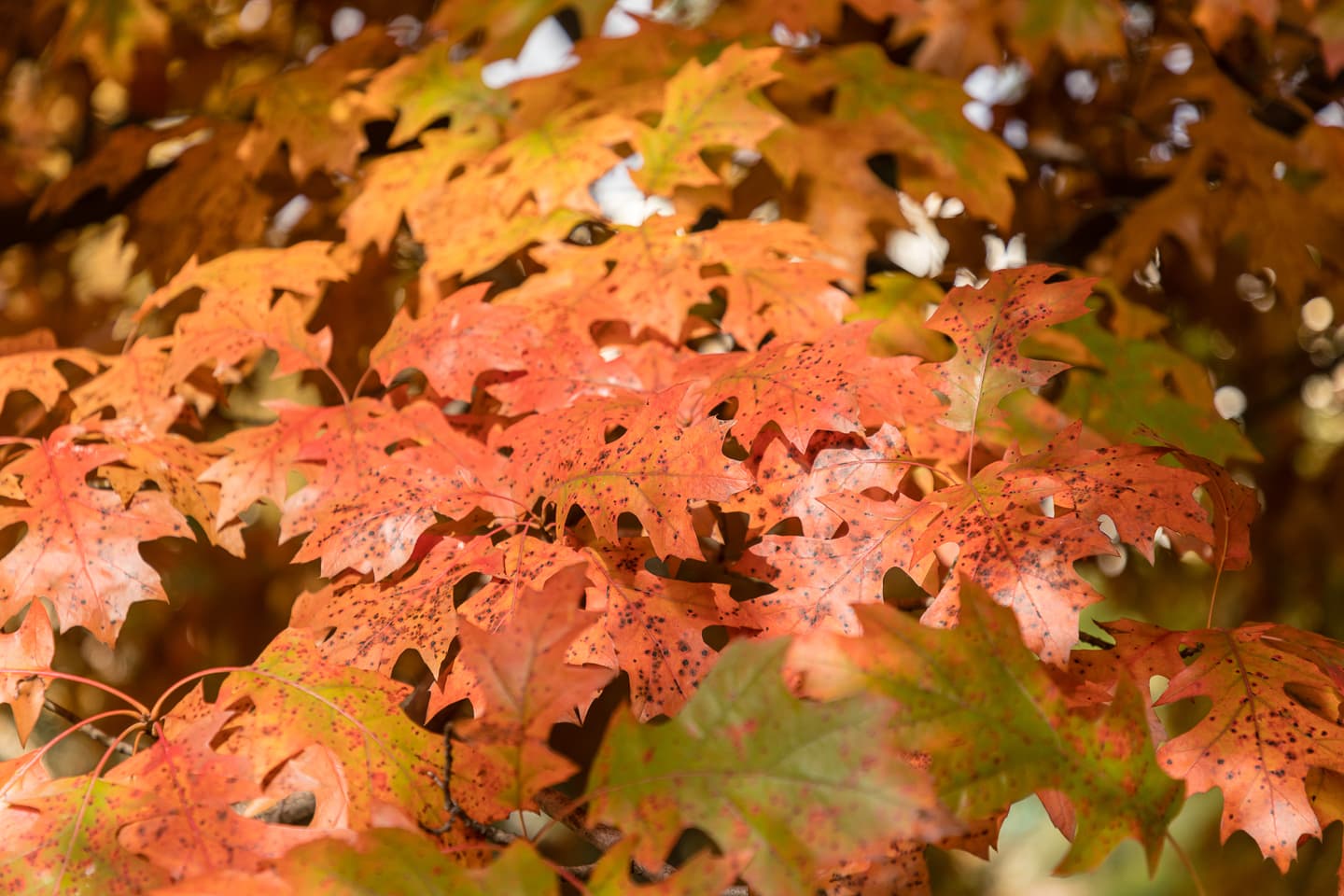
Scientific name: Quercus shumardii
Zone: 5 to 9
Exposure: Full sun
Height: 40′ to 60′ tall
Width: 40′ to 60′ wide
Bloom time: foliage only
Flower color: N/A
- Prefers well-drained soil
- A majestic tree with a broad canopy, its glossy green leaves turn a deep scarlet in the fall.
4 | Dogwoods
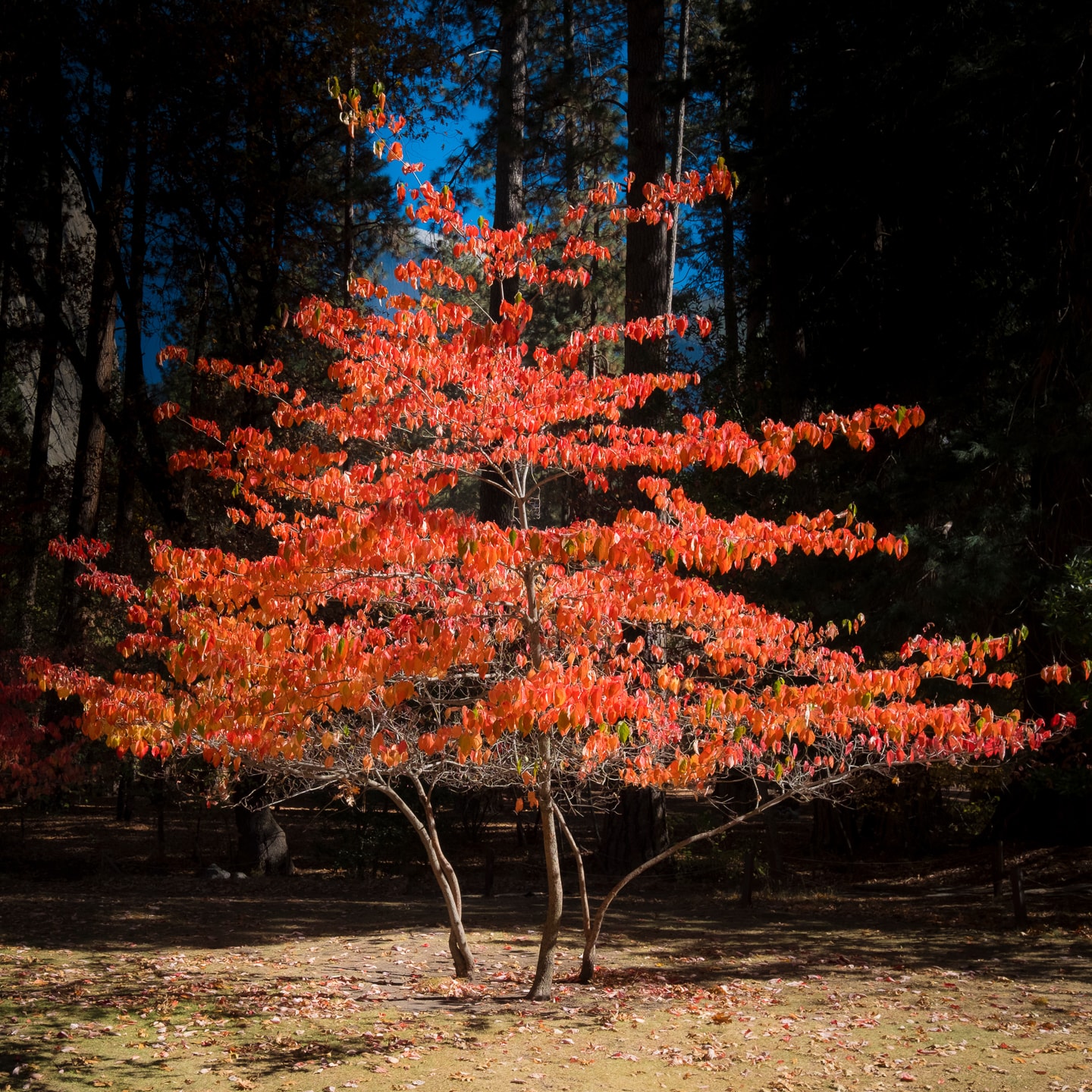
Scientific name: Cornus
Zone: 5 to 9
Exposure: Partial shade
Height: 15′ to 30′ tall
Width: 15′ to 30′ wide
Bloom time: Spring
Flower color: White, pink
Dogwoods are a diverse group of small trees and shrubs known for their showy flowers and attractive foliage.
Native to both North America and Asia, dogwoods are celebrated for their springtime displays of white, pink, or red bracts, and their bright red or purple fall foliage.
Many species also produce clusters of vibrant berries in late summer and fall.
Prefers acidic, well-drained soil
5 | canada red chokecherry
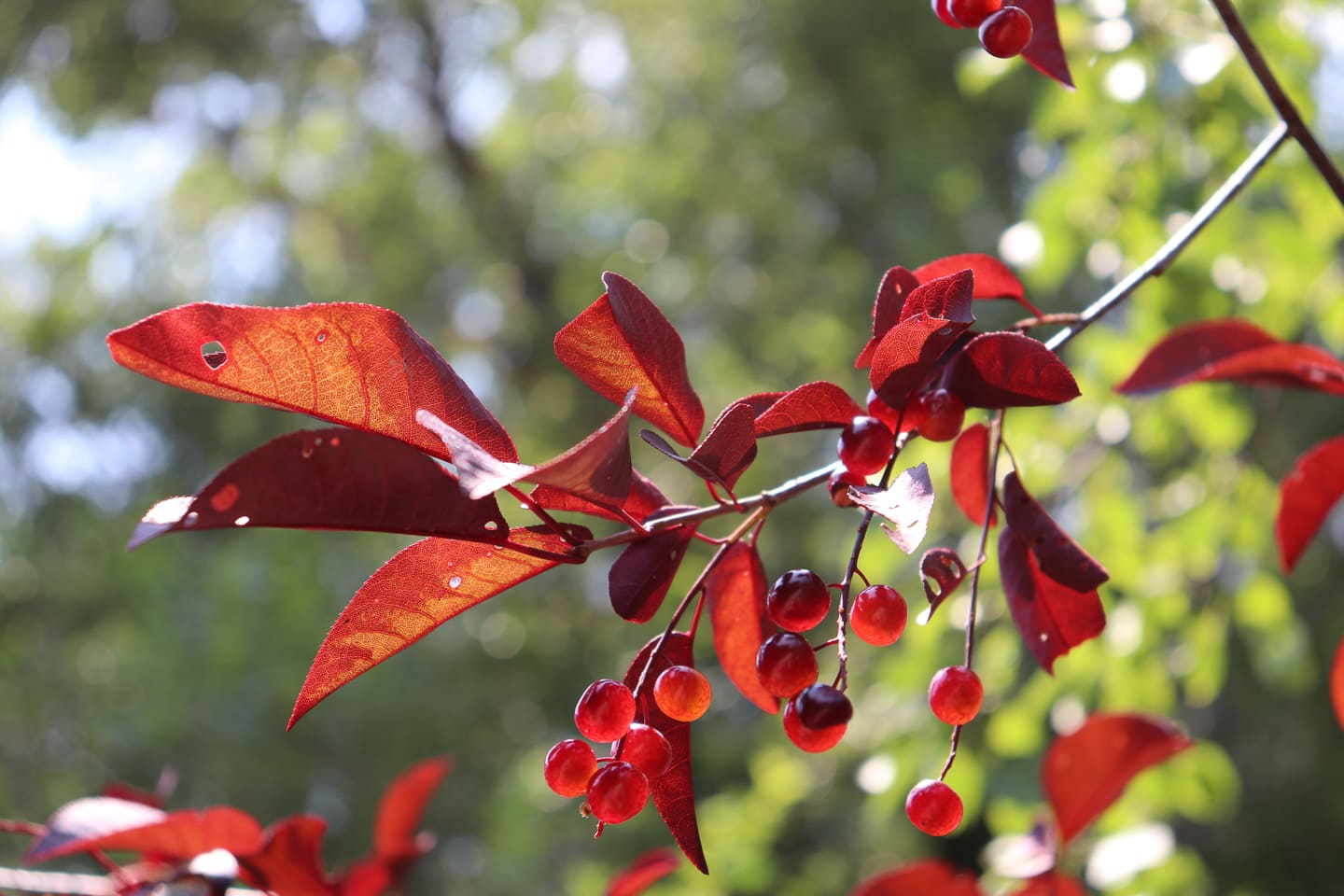
Scientific name: Prunus virginiana ‘Canada Red’
Zone: 2 to 7
Exposure: Full sun to partial shade
Height: 20′ to 30′ tall
Width: 15′ to 20′ wide
Bloom time: Spring
Flower color: white
The Canada Red Chokecherry is a striking ornamental tree known for its dynamic foliage transformation.
Emerging green in spring, its leaves mature to a deep purple-red hue as the season progresses, offering a vibrant contrast to many landscapes.
This deciduous tree also boasts clusters of fragrant white flowers in late spring, which give way to small, dark red berries by late summer.
While the berries are often too tart for direct consumption, they’re popular for making jellies and jams.
6 | Red Chinese Pistache Tree
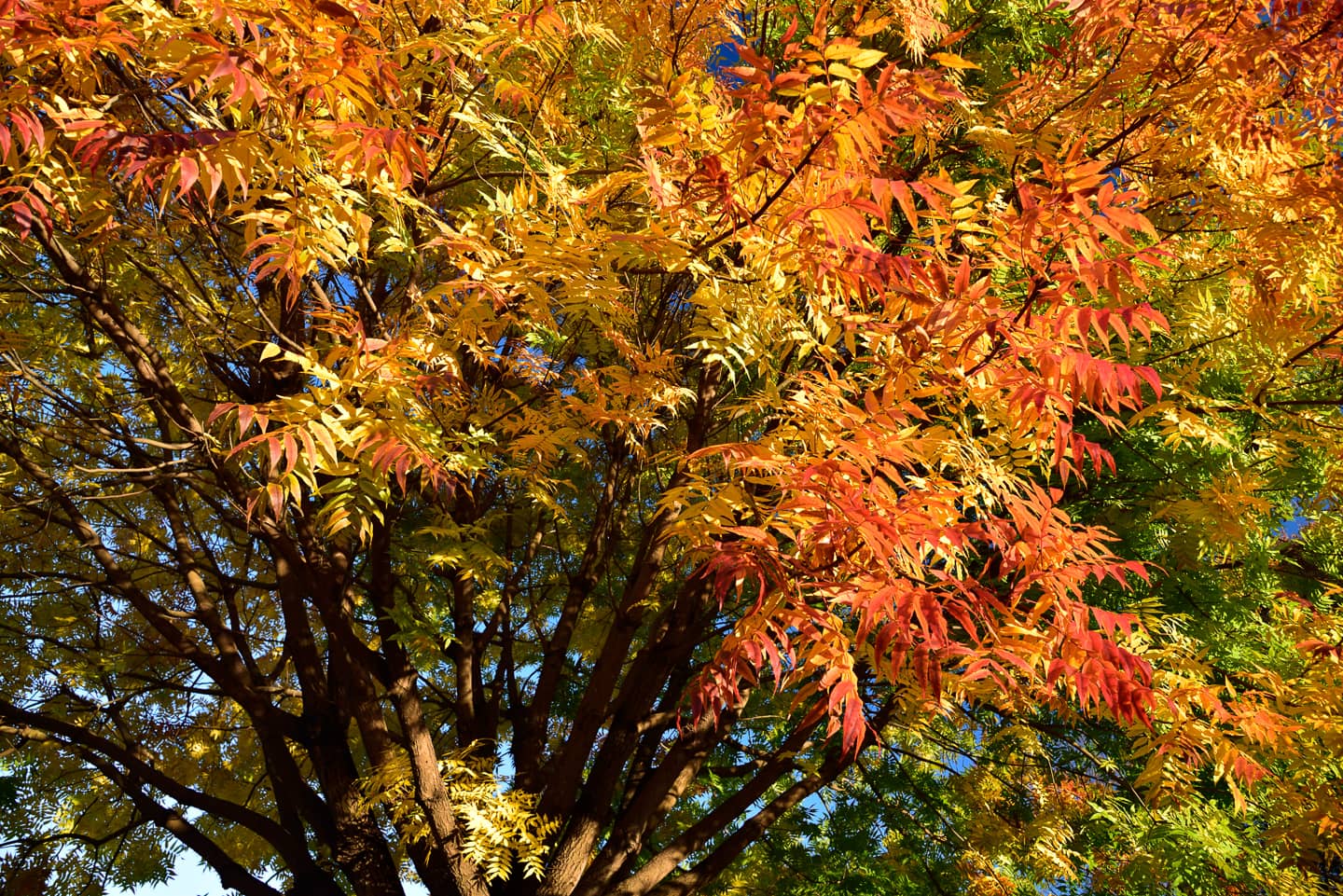
Scientific name: Pistacia chinensis
Zone: 6 to 9
Exposure: Full sun
Height: 25′ to 35′ tall
Width: 25′ to 35′ wide
Bloom time: foliage
Flower color: N/A
The Red Chinese Pistache is a medium-sized, deciduous tree celebrated for its spectacular autumn display.
As the seasons transition, its normally deep green leaves shift to vibrant shades of orange, red, and crimson, making it a standout in any autumn landscape.
Beyond its fall beauty, this tree is valued for its drought tolerance and adaptability to various soil types.
Its rounded canopy and spreading growth habit make it an excellent shade tree.
Often used as a street or ornamental tree, the Red Chinese Pistache is a resilient and visually striking choice for urban and suburban settings alike.
7 | crape myrtle
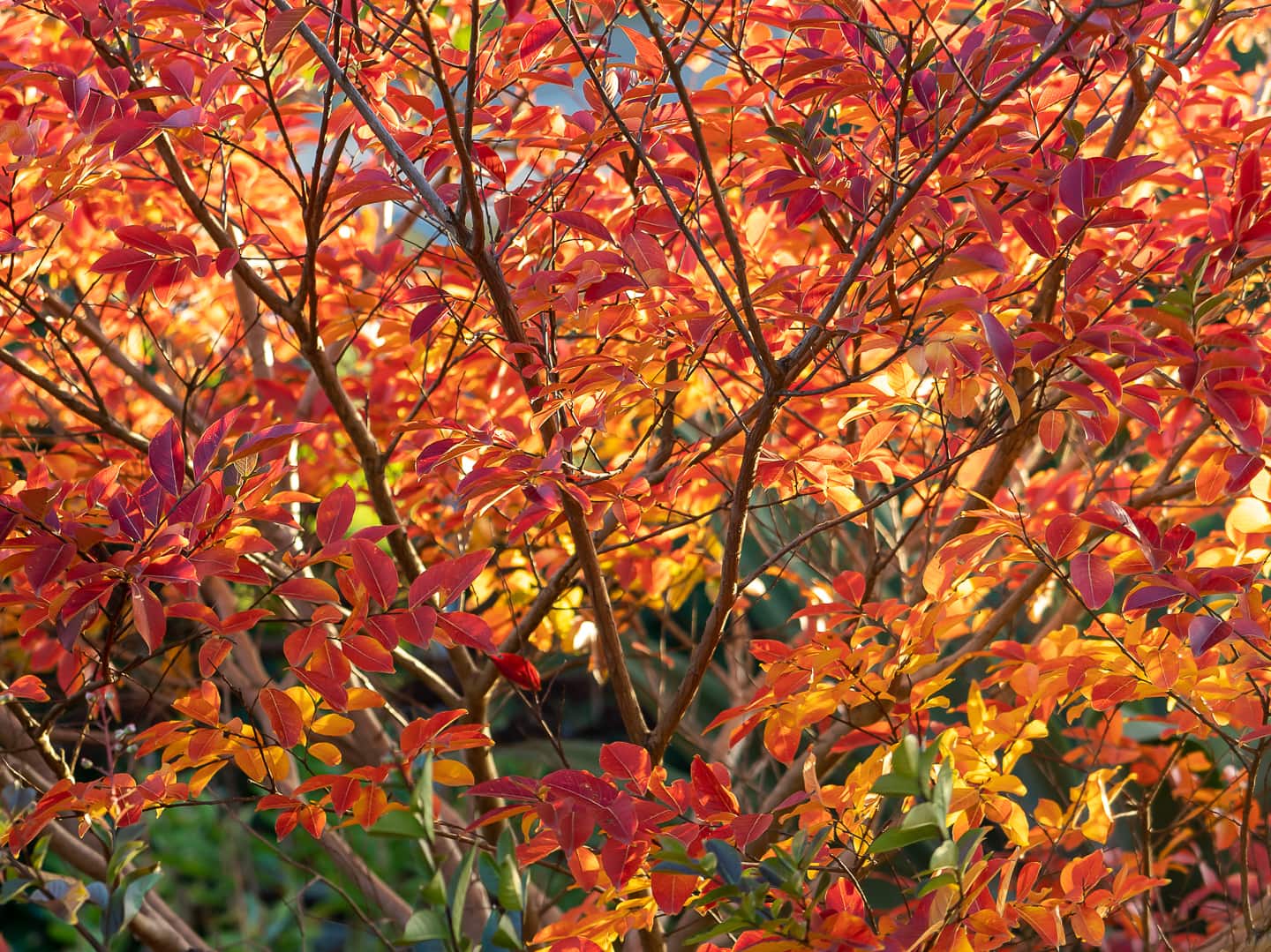
Scientific name: Lagerstroemia
Zone: 7 to 9
Exposure: Full sun
Height: 20′ to 30′ tall
Width: 15′ to 20′ wide
Bloom time: Summer to fall
Flower color: pink, white, red
Crape Myrtle is a beloved deciduous tree or shrub known for its profusion of vibrant and long-lasting summer blooms.
The flowers, which can range in color from white and pink to deep red and purple, appear in large, showy clusters.
Beyond its blossoms, Crape Myrtle is also admired for its brilliant orange and red fall foliage. As well as its smooth, peeling bark, which reveals a mottled surface of varying shades, adding winter interest.
Often used in landscaping for its multi-season appeal, drought tolerance, and resistance to pests, Crape Myrtle stands as a testament to both beauty and resilience in the garden.
8 | Redbud tree
The Redbud tree is a deciduous, small to medium-sized tree celebrated for its stunning early spring display.
Before the emergence of its heart-shaped leaves, the tree is adorned with a profusion of pink or lavender blossoms that bloom directly on its branches and trunk.
As seasons progress, its foliage can range from rich green to varieties with deep purple or variegated leaves.
In the fall, some species showcase a delightful transition to red, orange or golden-yellow hues
The best varieties for red fall leaves are:
Flame thrower redbud
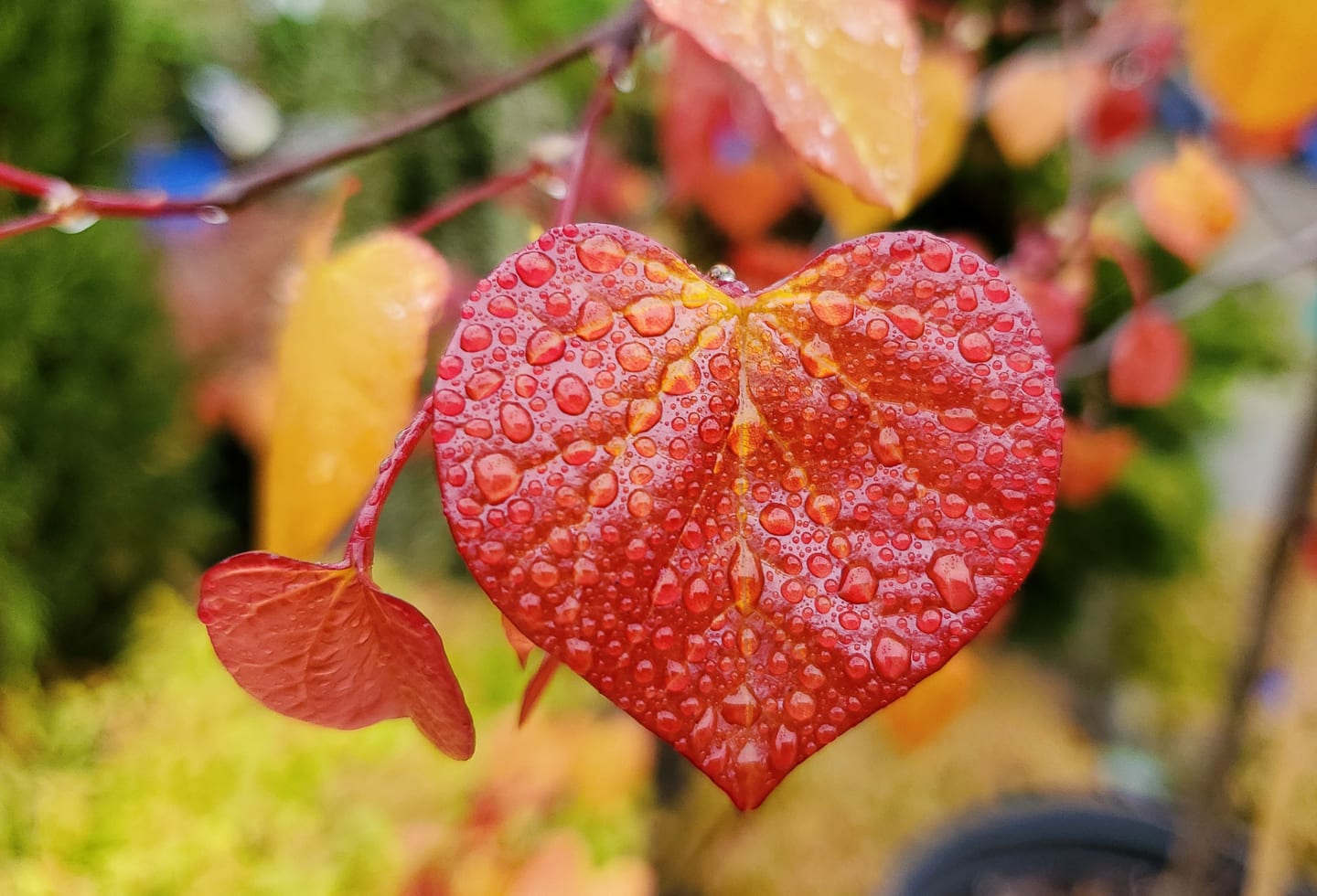
Scientific name: Cercis canadensis
Zone: 5 to 9
Exposure: Full to partial sun
Height: 15′ to 20′ tall
Width: 15′ to 20′ wide
Bloom time: Spring
Flower color: Pink
- This variety boasts leaves that transition from burgundy to lime, then to gold, and finally to a fiery orange-red in the fall.
Forest Pansy redbud
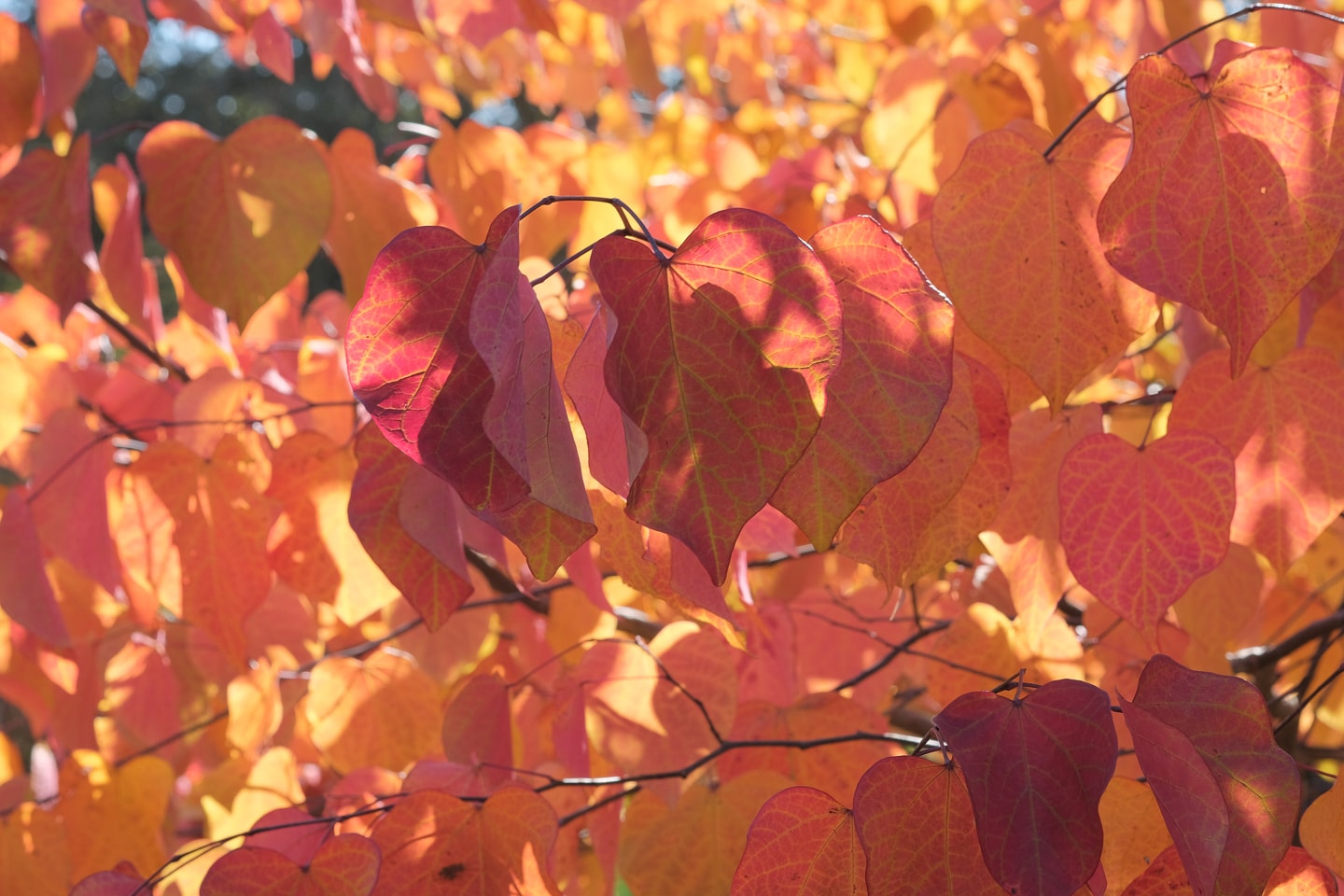
Scientific name: Cercis canadensis
Zone: 5 to 9
Exposure: Full to partial sun
Height: 20′ to 30′ tall
Width: 25′ to 35′ wide
Bloom time: Spring
Flower color: Pink
- This variety has purple-red leaves all season that intensify into a bright red color in the fall.
9 | Black gum
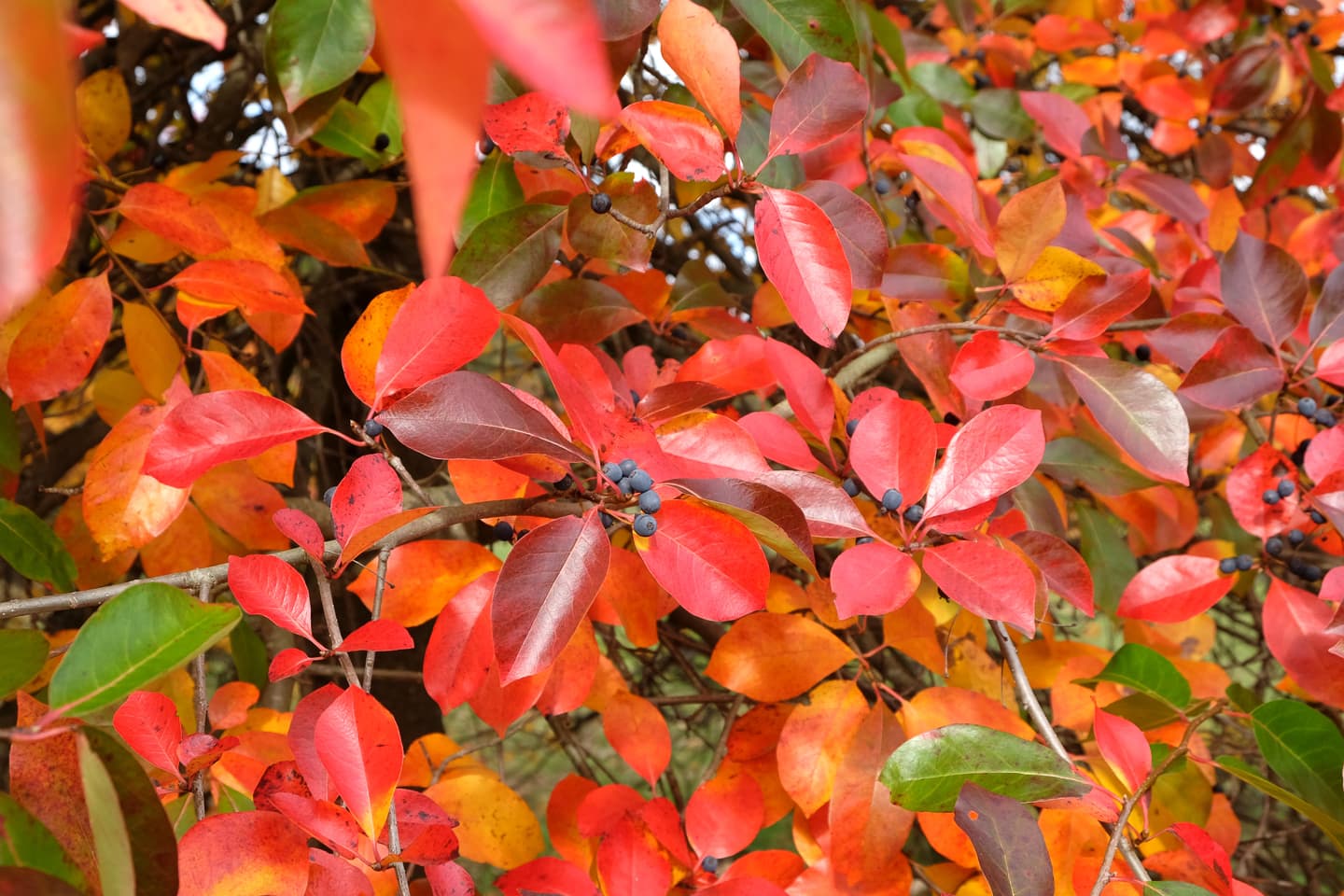
Scientific name: Nyssa sylvatica
Zone: 4 to 9
Exposure: Full sun to partial shade
Height: 30′ to 50′ tall
Width: 20′ to 30′ wide
Bloom time: foliage only
Flower color: N/A
The Black Gum is a deciduous tree renowned for its brilliant autumnal display.
As the seasons shift, its glossy green leaves transform into vibrant shades of scarlet, orange, and deep purple, making it a standout in the fall landscape.
Beyond its fiery foliage, the Black Gum is valued for its adaptability to various soil types and its small, blue-black fruit that attracts wildlife.
10 | Serviceberry
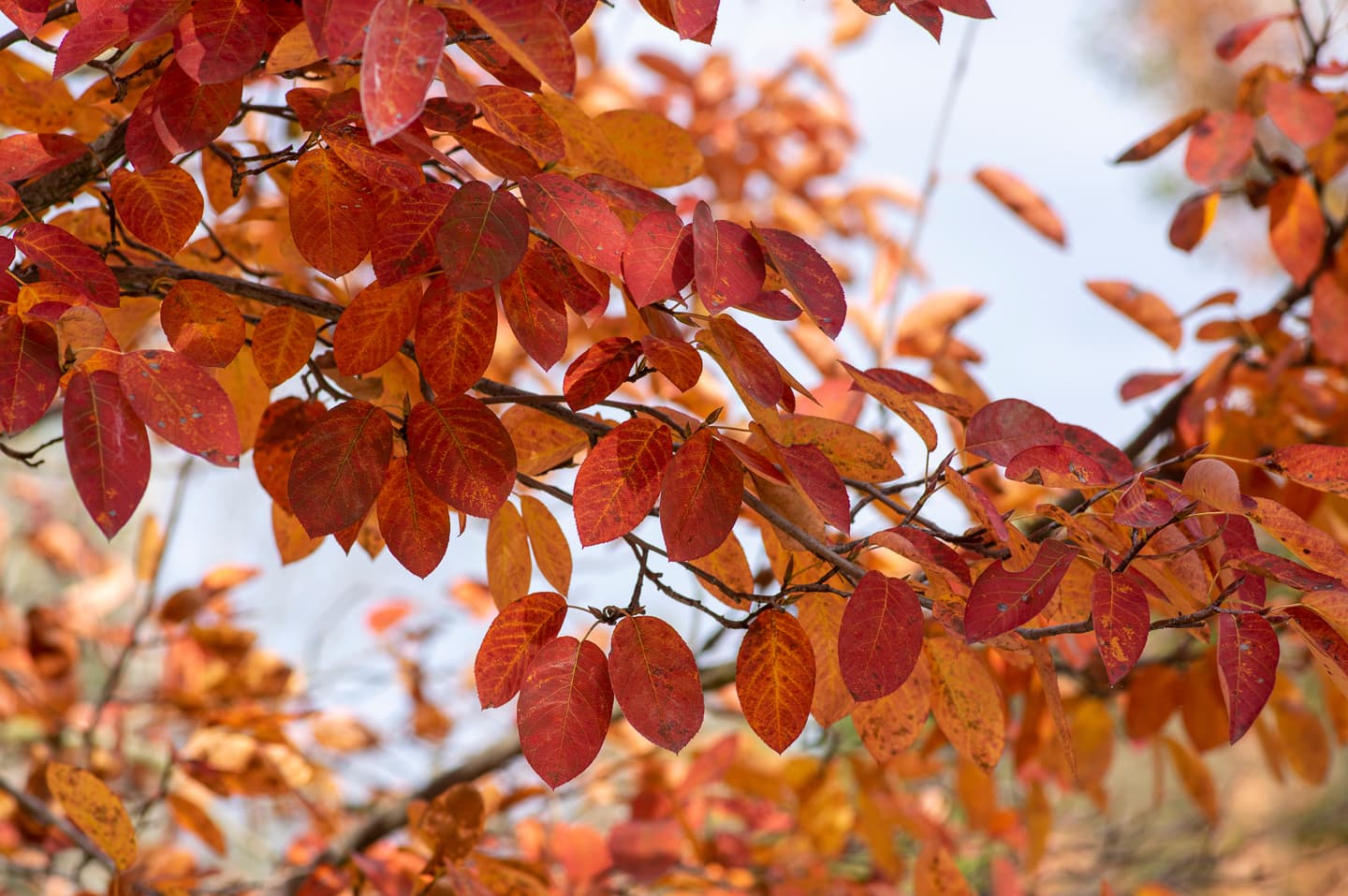
Scientific name:
Zone: 4 to 9
Exposure: Full sun to partial shade
Height: 6′ to 20′ tall (depending on the variety)
Width: 4′ to 15′ tall (depending on the variety)
Bloom time: Spring
Flower color: white
Serviceberry, often referred to as Juneberry or Shadbush, is a deciduous shrub or small tree celebrated for its multi-season appeal.
In early spring, it bursts into a display of delicate white blossoms, followed by sweet, blueberry-like fruits in early summer that attract various wildlife.
Its leaves, initially a soft green, transition to brilliant shades of orange, red, and gold in the fall.
11 | Sourwood
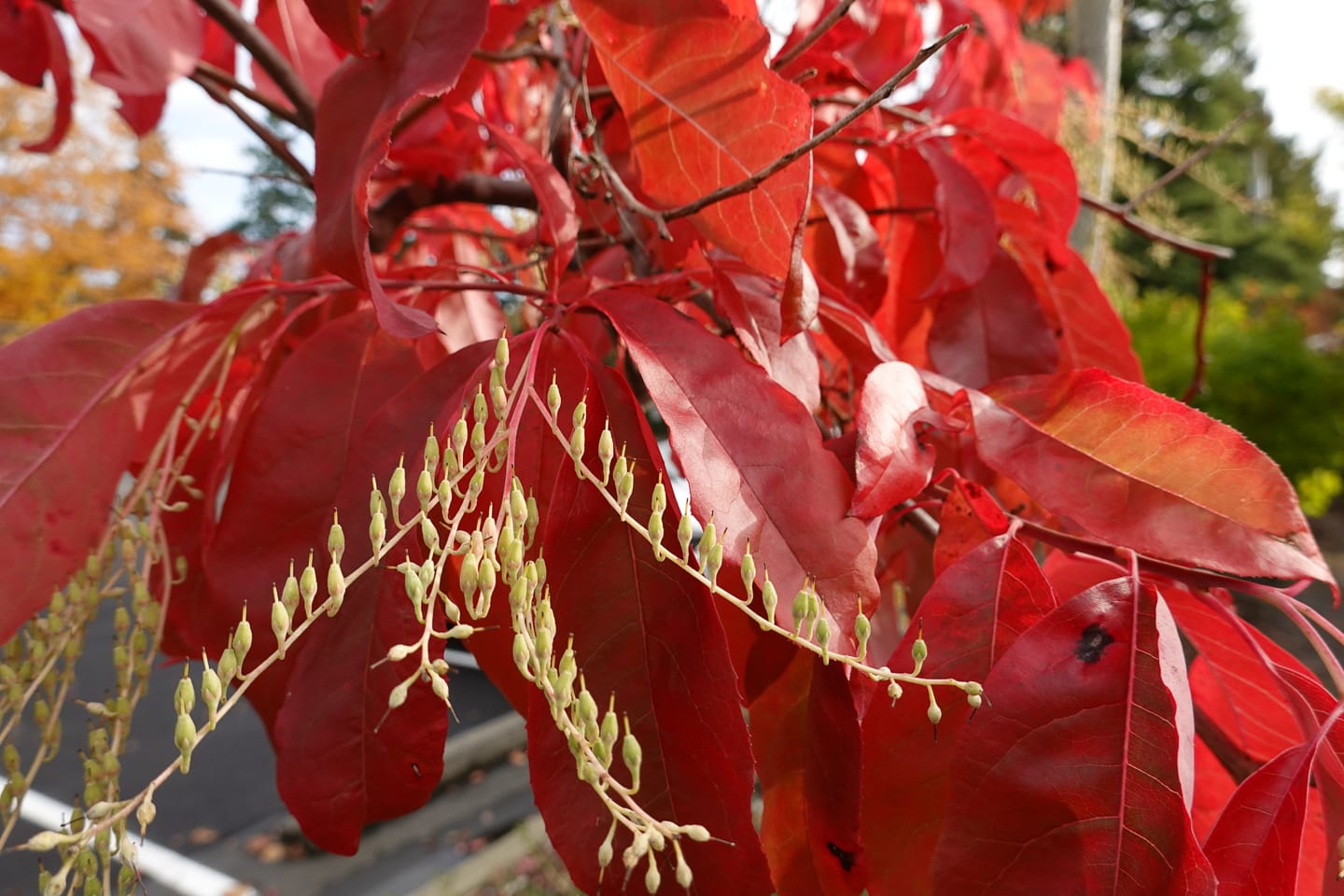
Scientific name: Oxydendrum arboreum
Zone: 5 to 9
Exposure: Full sun to partial shade
Height: 25′ to 30′ tall
Width: 20′ wide
Bloom time: Summer
Flower color: white
Sourwood is a deciduous tree known for its cascading clusters of fragrant white flowers in summer, resembling lily-of-the-valley.
As the seasons transition, its elongated, glossy green leaves turn a vibrant shade of crimson, orange, or purplish-red, offering a spectacular autumn display.
The tree also produces small, decorative seed capsules that persist into winter.
Often found in the understory of forests, Sourwood’s unique blooms, brilliant fall color, and slender, pyramidal growth habit make it a standout choice for gardens and landscapes seeking both beauty and character.
12 | Bald Cypress
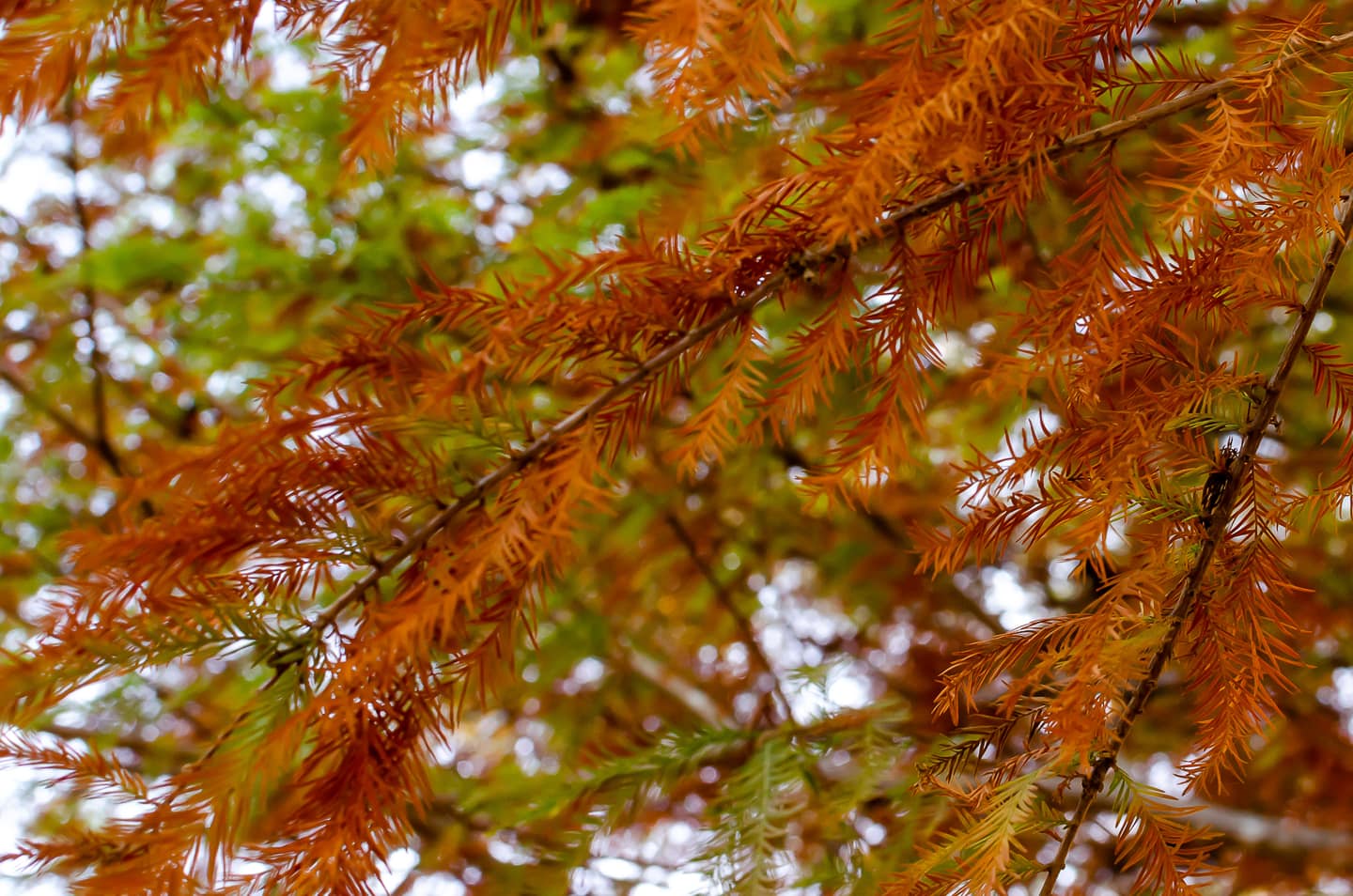
Scientific name: Taxodium distichum
Zone: 4 to 9
Exposure: Full sun
Height: 50′ to 70′ tall
Width: 20′ to 30′ wide
Bloom time:
Flower color:
Bald Cypress is a deciduous conifer known for its tall, straight trunk and feathery, needle-like leaves.
Unique among conifers, it sheds its needles in the fall, transforming into a striking rusty-red before they drop.
Often found in wetlands, the tree is also recognized for its distinctive “knees” – woody projections that emerge from the ground around the tree. These adaptations allow it to thrive in waterlogged conditions.
With its elegant form, autumnal color, and adaptability to wet environments, the Bald Cypress stands as a majestic sentinel in both natural wetlands and urban landscapes.
Frequently asked questions
Why do some trees turn red in the fall?
As the days shorten and temperatures drop in the fall, chlorophyll, which gives leaves their green color, breaks down. This allows other pigments, like anthocyanins (which produce red and purple hues), to become more prominent.
Which tree species are known for their red fall foliage?
Some popular trees with red fall foliage include Red Maple (Acer rubrum), Sugar Maple (Acer saccharum), Japanese Maple (Acer palmatum), Scarlet Oak (Quercus coccinea), and Dogwood (Cornus species).
Is the intensity of the red color the same every year?
No, the intensity can vary based on factors like temperature, moisture, and soil conditions. Cool nights and sunny days in the fall can enhance the red pigmentation in leaves.
Do all trees change color in the fall?
Not all trees change color. Evergreen trees, like pines and firs, retain their green color throughout the year. Only deciduous trees, which shed their leaves annually, go through this color change.
How long do the red leaves typically last?
The duration of the fall color display can vary based on weather conditions, tree health, and species. Typically, the vibrant colors can last a few weeks before the leaves drop.
Other fall plants you might like
- Fall Container Plants: 18 Eye-Catching Annuals & Perennials
- Planting Fall Bulbs: How to Plant Tulips and Other Spring-Flowering Bulbs
- Fall Perennials & Shrubs (15 of the Best Plants For Fall Flowers)
Or browse all of our fall plant ideas.
Have comments or questions about trees that turn red in fall? Tell us in the section below.
This post was originally published on September 13, 2023 but was updated with new content on April 9, 2024.

